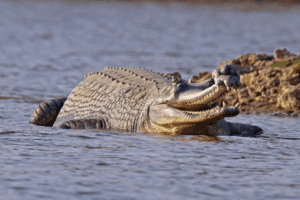TAG: GS 3: ECOLOGY AND ENVIRONMENT
THE CONTEXT: A lone female gharial, spotted for over three years in a stretch of the Brahmaputra river within the Kaziranga National Park and Tiger Reserve, has recently drawn significant attention.
EXPLANATION:
- This female gharial holds promise for the repopulation of the species in the region, potentially ending her solitary existence with the introduction of mates.
The Gharial’s Presence in Kaziranga
- The female gharial was first seen in 2021 in the Biswanath Wildlife Division of Kaziranga, which spans 1,307.49 sq. km.
- Over 80% of this 401 sq. km area consists of water bodies, mainly a 107-km stretch of the Brahmaputra.
- Distinguished by its elongated snout, the gharial (Gavialis gangeticus) is a unique crocodilian species believed to have disappeared from the Brahmaputra in the 1950s, with sporadic claims of sightings in the 1990s.
- Now measuring 2.55 meters in length, the female gharial has been recorded basking at different locations within the priority habitats during a 10-day survey of aquatic reptiles along the Brahmaputra in January.
- Teams from the Turtle Survival Alliance Foundation India (TSAFI) and the Assam Forest Department conducted this survey over a 160 km stretch from the Kaliabhomora bridge to Majuli’s Kamalabari Ghat.
Survey Findings
- The survey revealed a diverse aquatic fauna in the Brahmaputra within the Biswanath Wildlife Division.
- A total of 990 freshwater turtles from five species were recorded: the Assam roofed turtle, Indian tent turtle, Brown roofed turtle, Indian or Gangetic softshell turtle, and Peacock softshell turtle.
- Additionally, more than 80 other major aquatic species, including the Gangetic river dolphin (Platanista gangetica), were documented.
- The female gharial was found navigating between a sandy shoreline and a sand bar with a shoreline water depth of 4.5 meters.
- This solitary gharial, identified as female due to the absence of the ghara on its snout, has managed to survive in the Brahmaputra despite the absence of a mate for over three years.
Historical and Geographical Context
- Historically, gharials were widely distributed across the Brahmaputra, Ganga, Indus, and the Mahanadi-Brahmani-Baitarani river systems in India, Bhutan, Bangladesh, Nepal, and Pakistan.
- Today, significant populations of gharials are confined to the Chambal and Girwa rivers in India, and the Rapti-Narayani river in Nepal.
Reintroduction Proposal
- The survey report, submitted in June, included ten recommendations, with a high-priority proposal for the reintroduction of gharials in the Brahmaputra landscape, especially within the Biswanath Division.
- The report highlighted the suitability of the habitats in supporting the long-term survival of the species.
- The potential for a gharial breeding program in the tiger reserve has been acknowledged.
- The absence of fishing activities in the Brahmaputra within the Biswanath Division ensures ample food supply for the fish-dependent gharials.
- Additionally, the female gharial’s survival through multiple floods indicates the species’ potential resilience in the flood-prone Brahmaputra environment.
Implementation of Reintroduction
- If approved, the reintroduction program will likely source gharials from the Kukrail gharial breeding center near Lucknow, Uttar Pradesh.
- The program will initially focus on introducing juveniles and sub-adults to facilitate faster acclimatization to the Brahmaputra and its channels.
Gharial (Gavialis gangeticus)
- The gharial (Gavialis gangeticus), also known as gavial or fish-eating crocodile, is a crocodilian in the family Gavialidae and among the longest of all living crocodilians.
- Mature females are 2.6 to 4.5 m (8 ft 6 in to 14 ft 9 in) long, and males 3 to 6 m (9 ft 10 in to 19 ft 8 in).
- Adult males have a distinct boss at the end of the snout, which resembles an earthenware pot known as a ghara, hence the name “gharial”.
- The gharial is well adapted to catching fish because of its long, narrow snout and 110 sharp, interlocking teeth.
- The gharial probably evolved in the northern Indian subcontinent.
- Fossil gharial remains were excavated in Pliocene deposits in the Sivalik Hills and the Narmada River valley.
- It currently inhabits rivers in the plains of the northern part of the Indian subcontinent.
- It has been listed as critically endangered on the IUCN Red List since 2007.


